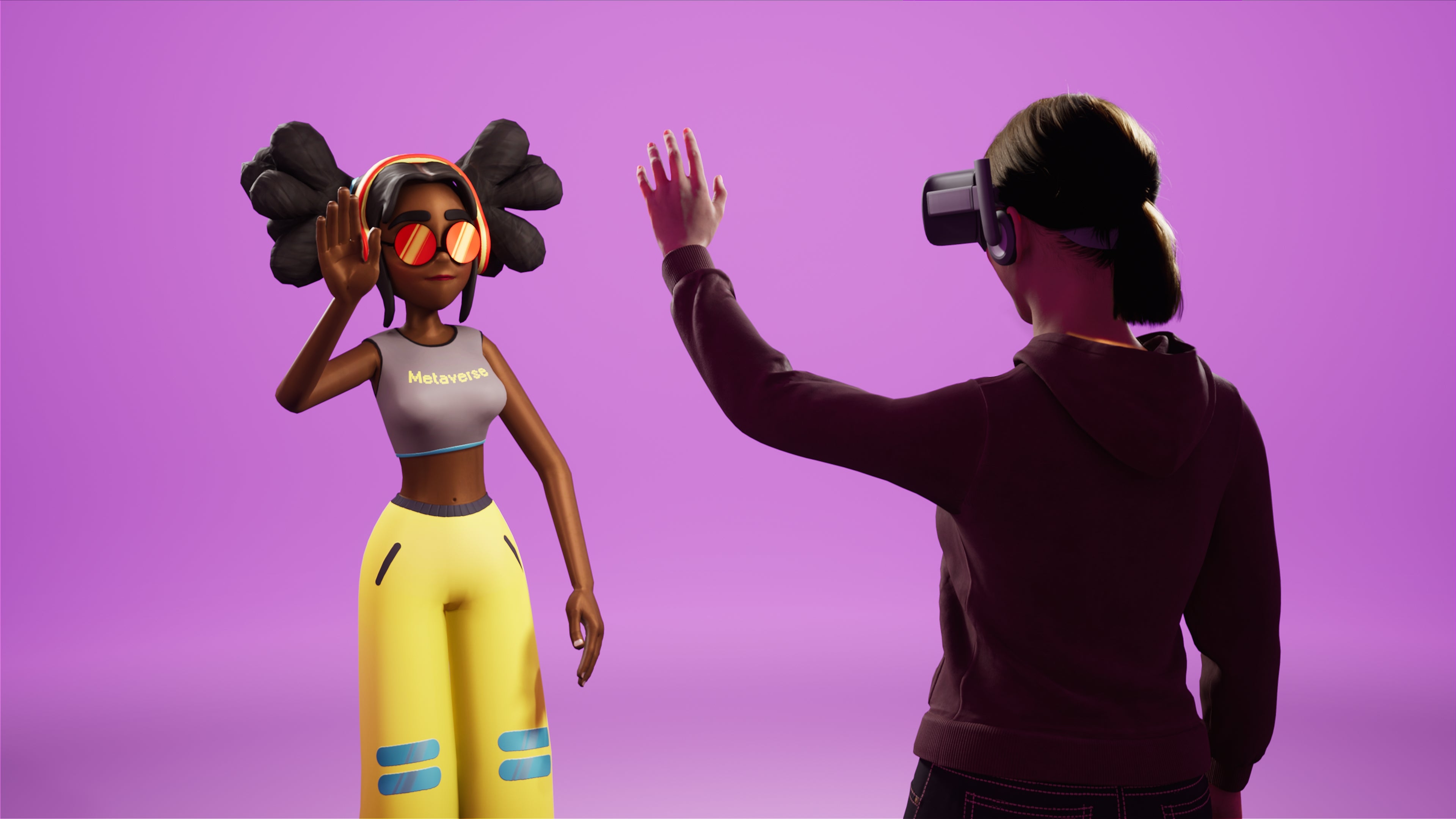Original artwork by Richard Borge for ACC.
Cheat Sheet
- The metaverse. First coined in a novel in 1992 and often described as a network of 3D virtual worlds, there is no clear definition of the metaverse.
- In-house involvement. As companies expand into the metaverse, their in-house counsel are at the table aiding these decisions and leading the charge into the undefined legal space.
- The future of labor and employment law. With employees engaging in extended reality, employers will have to consider online code of conducts, crypto-compensation, and liabilities.
- Intellectual property (IP), data privacy, and jurisdiction. The unique issues IP and data privacy present in global and international matters will compound in virtual words and present new problems and questions for lawyers.
In 1992, American author Neal Stephenson coined the term “metaverse” to describe the fictional world in his novel, Snow Crash. Metaverse was used to describe a world where people interact with various types of software in a three-dimensional space.
Wikipedia’s description of the metaverse is a “network of 3D virtual worlds” with the convergence and shared features based on what the internet will offer in the future. And the Merriam-Webster Dictionary has the term noted on its “Words We’re Watching” page with a note that the word is too new to thoroughly describe and list in its main pages. Despite a great deal of mainstream coverage on the topic, a clear definition has not surfaced. It’s not surprising, therefore, that Black’s Law Dictionary hasn’t listed it.
And so, as we are about to dive into a virtual space, a place where digital and physical worlds converge, we don’t know how much our current laws apply.
Come with me and you’ll be in a world of virtual imagination
We’ll overlay a few legal concepts on a shifting word in this article that will no doubt bring much angst to our future selves. With millions of people already spending countless hours immersed in a three-dimensional virtual world (video games, running virtual businesses, etc.), some would say lawyers are late to the game already.
With millions of people already spending countless hours immersed in a three-dimensional virtual world (video games, running virtual businesses, etc.), some would say the lawyers are late to the game already.
Conversely, others might say we are leading the charge. After all, profit-seeking companies are currently controlling the metaverse narrative and that means in-house counsel are at the table aiding in the decisions. Well-known tech giants like Microsoft, Facebook (Meta), and Nvidia are pushing the value up while a chorus of investors and startups try to jump on the bandwagon as well.
But don’t hitch a horse to the wagon just yet. Many believe the metaverse will only work if people have a sense of belonging, participating in a shared synchronous experience … even if they are not being paid to show up.

Current metaverse platforms serve as a case study of triumph and error for newcomers. Decentraland is a vast virtual world where users can buy virtual real estate and clothing, play games, attend concerts, hang out with other users, sell products and services, and explore. Decentraland is decentralized, meaning it is controlled by a network of users rather than one centralized entity. The platform has its own cryptocurrency, MANA, and users interact and purchase property in a space known as LAND.
The Decentraland Autonomous Organization (DAO), Decentraland’s decision-making tool, controls smart contracts regulating virtual real estate, naming rights, avatar clothing, and holds a sizeable amount of MANA to support community grants and maintain the platform. Through the DAO, users can vote on proposals to fund a community project, add or remove a point of interest, or ban harmful usernames. The Security Advisory Board (SAB), a group of elected users, must vote to approve any changes to LAND contracts.
Despite buy-in from multi-million and billion-dollar investors, Decentraland has not escaped criticism. Specifically,
- MANA being tied to a volatile crypto market;
- High real estate cost – prices have skyrocketed to anywhere from US$500,000-3.5 million for the most in-demand virtual properties;
- Long load times and technological bugs;
- A rigid governance process — users were unable to gather enough votes to ban the name “Hitler” via the DAO; and
- Lackluster user experiences — raves and concerts on the platform have been called out for being “boring and dead.”
Some believe the metaverse is merely Second-Life 2.0 by Linden Lab, a two-decade-old virtual world. Linden Lab’s engagement has been, according to their data, complicated. Specifically:
- Generating US$600 million annual gross domestic product (GDP);
- Creating more than US$2 billion user-generated assets; and
- Paying more than US$80.4 million to creators per year.
Growth has been slow over the past 20 years for Second-Life, and many metaverse believers contribute the creeping expansion to three main design differences:
- Anti-speculative market protections via a central bank;
- Inflation controls to keep the exchange rate of virtual currency in check; and
- Policies like a dropping the price of virtual land.
Since the metaverse relies on cryptocurrency and blockchain, many believe these technological differences will allow the platform to grow at an explosive rate, thereby allowing advertising/attention-based business models to scale quickly.
Should social connection evolve with the metaverse, there’s still a need to correct the lack of empathy on current online social media platforms. For instance, current communication spaces are filled with biases, hate, and anti-social behavior. While emoji have tried to fill this gap, the emotional connection remains the linchpin to success.
If success is built on the need for the metaverse to be a trust-based environment, then traditional laws like employment and labor, contracts, IP, and privacy will
need to be understood.
As we all get ready to build our expressive personas (avatars) and buy our dream piece of virtual land, those steering this ship will need to create a safe space for the full range of human expression to roam, without violating any real-world laws.
Glossary of metaverse terms
AR (Augmented Reality): Technology used to create an enhanced version of the physical world overlaid by digital information, visual elements, and sensory stimuli delivered via an electronic device.
Avatar: An image use to represent individual users.
BCI (Brain-Computer Interface): A form of interface that allows users to go directly from thought to a computer system (i.e., a chip installed in their brain).
Blockchain: A shared accounting system used to store and process transactions and assets from cash to property, including tangible and intellectual.
Cryptocurrency: Digital currency like bitcoin and ether that are based on blockchain architecture.
DAO (Decentralized Autonomous Organization): An internet community owned by its members and run on blockchain technology, using smart contracts that use code to establish rules and automatically execute decisions.
Metaverse: A “world” of user-created 3D virtual spaces in which people can work, play, shop, and socialize.
MMORPG (Massively Multiplayer Online Role-Playing Game): Video games in which millions of people interact in shared spaces.
Mirror World: An artificial intelligence, digital version of the real world that represents real people, places, and things (is part of the term, simulated reality).
MR (Mixed Reality): A blend of physical and digital worlds that interact in real-time.
NFT (Non-Fungible Token): A type of digital asset that exists on a blockchain, which can allow proof of ownership of goods in the metaverse.
SSI (Self-Sovereign Identity): A form of digital identity that provides the user full control and ownership over the identity, often built on a blockchain and not beholden to any centralized authority.
Skeumorphic Design: Like Mirror World, except the virtual objects only resemble — are not identical to — the real-world ones.
Telepresence: A digital teleportation, which is the ability to “travel” to a remote physical or virtual location via AR or VR.
VR (Virtual Reality): A computer-generated simulation of a 3D image or environment that can be interacted with by a person using special equipment.
Web2: Websites that provide user-generated content designed to motivate online interaction.
Web3: The next phase of the internet which is decentralized (perhaps running on blockchain) and not dominated by major online companies.
XR (Extended Reality): An umbrella term that covers VR, AR, and MR.
Zero Knowledge Proofs: Algorithms that permit two users to share a piece of information without the grantor disclosing any additional information to the grantee used to verify something, like a statement.
Avatars and the blockchain: How does this affect the future of labor and employment law?
Due to the pandemic, employers have begun relying on remote work options to protect employee health, maintain productivity, save costs, and retain talent. Employers are just getting accustomed to this change, however, the metaverse will introduce new challenges to the workplace, whether virtual or in real life.
Online behavior
Current applications like Second-Life or Horizon Venues, Meta’s metaverse, serve as a case study for adapting to the metaverse and can provide employers with a glimpse of future trials and tribulations.
In 2007, a Second Life user reported a “virtual rape” on the platform allegedly committed by a Belgian user. In 2022, a woman claimed she was “verbally and sexually harassed” on Horizon Venues, when a group of men virtually groped her avatar and made sexually explicit comments. Second Life has built “safety bubbles” around users’ avatars.
More than 600 virtual reality (VR) users — 49 percent female and 36 percent of male — said they were sexual harassed in the metaverse, according to a 2018 survey. Often, this harassment occurs when one user virtually gropes or makes sexually explicit comments towards a non-consenting user’s avatar.
With the rise of the #MeToo movement bringing to light systemic sexual harassment in the workplace, employers must prepare to address these concerns in a virtual world where employees are under less supervision and inhibitions run freer at home.
... With great customization comes great concerns of
abuse and toxicity
in the
virtual workplace.
To combat sexual harassment, some companies dabbling in the metaverse have created features limiting how close two avatars can get to one another and concealing an avatar’s hands when getting too close to another user.
Discrimination
As sexual harassment has been thrust into the spotlight, so has discrimination based on race, sex, disability, age, and other protected class status. Taking center stage will be company policies related to employee avatars. Since the metaverse allows users to express themselves through avatar customization, an employee may mirror their in-real-life (IRL) male or female appearance or decide to represent their identity with an avatar of another gender. While this provides opportunities to express one’s identity, with great customization comes great concerns of abuse and toxicity in the virtual workplace.
For example, what if a white employee creates a Black avatar? Now, what if that Black avatar is designed with exaggerated racial stereotypes? What if an employee makes negative comments about another employee’s avatar’s skin color or use of a wheelchair?

While there are no one-size-fits-all solutions to address harassment or discrimination in the virtual workplace, employers should:
- Update employee handbooks and trainings to address virtual behavior; prepare to receive and investigate complaints.
- Treat virtual harassment and discrimination the same as their IRL counterparts.
- Plan to handle complaints lodged against third-party actors like vendors or independent contractors.
- Consider whether the virtual workplace provides further avenues for accommodation, such as those required under the Americans with Disabilities Act.
Cryptocurrency and non-fungible token paychecks
The blockchain has been inextricably tied to the metaverse with the rise of cryptocurrency and non-fungible tokens (NFTs). As popular cryptocurrencies have skyrocketed in value in recent years, employers should expect requests by employees to receive crypto-compensation. Employers entertaining such inquiries must consider how these payments may be regulated, such as under US state laws and the US Fair Labor Standards Act (FLSA).
As popular cryptocurrencies have skyrocketed in value in recent years, employers should expect requests by employees to receive crypto-compensation.
For instance, the FLSA requires wage payments “in cash or negotiable instrument payable at par.” While the US Department of Labor (DOL) has published guidance allowing for the payment of wages in foreign currency, it remains to be seen where the DOL stands on cryptocurrency. Similarly, many US states additionally restrict the payment of wages, requiring payment in cash and/or without the employee incurring a fee for converting cash into crypto. Employers seeking to retain top talent through crypto payments must stay current on state and federal guidance while monitoring the fluctuating crypto markets.
Unions and strikes
Unionized employers may face additional hurdles. The virtual workplace will provide employees with new avenues to participate in concerted activity. Virtual picketing and strikes may become a cost-effective way to convey the pro-union message. Employers should not be surprised to see the US National Labor Relations Board adopt new procedures to facilitate virtual-representation elections or arbitrations that may strengthen the voting as well as the grievance process.
Virtual picketing and strikes may become a cost-effective way to convey the
pro-union message.
Physical injuries
Although the metaverse exists in a 3D virtual world, the risk of IRL physical harm to users is real. Due to the inherent sensory deprivation of VR headsets, early adopters of the VR experience have reported serious injuries including fractured and broken limbs, concussions, cuts, and even a fractured spine.
The US Occupational Safety and Health Administration (OSHA) regulates and inspects worksites to ensure employee health and safety. Typically, OSHA does not inspect home offices or hold employers liable for injuries occurring in an employee’s home office; however, an employee’s work-related, home-office injury is recordable on an employer’s OSHA log. Whether an employee’s injury is related to work will be fact determinative.
If an employee, using a VR headset, is injured as they run and trip to care for a crying baby, then that injury will likely not be recordable; however, if that same employee breaks their hand after accidentally punching a wall while making exaggerative hand gestures during a VR work presentation, then that injury likely is recordable. Knowing when to record an at-home injury can be confusing for employers, and failure to properly record can lead to citations and costly fines.
... Serious injuries including fractured and broken limbs, concussions, cuts, and even a fractured spine.
While individuals have been wading into the metaverse waters, employers will soon be thrown into the deep end. It remains to be seen who will sink and who will swim.
IP ownership and commercialization in a meta-reality
If you think the metaverse is complicated already, imagine the impact that it has on intellectual property law. In the words of Disney’s Aladdin, it’s a “whole new world!” IP already presents unique issues globally, so in virtual worlds, designed by developers and companies, protecting these intellectual property assets will present new problems for lawyers to tackle. Imagine lawyers from a wide variety of practice areas working through their own assumptions regarding the scope of the metaverse as they try to legally define IP rights in a virtual world that has no borders.
Imagine lawyers from a wide variety of practice areas working through their own assumptions regarding the scope of the metaverse as they try to legally define IP rights in a virtual world that has no borders.
Sports, entertainment, and intellectual property in the metaverse
Intellectual property law is at the center of the huge commercial opportunities offered by the sports and entertainment industries. These rights (especially patents, trademarks, and broadcasting rights), and the legal protections they provide, help to secure the economic value of sport. This in turn stimulates growth of the industries and enables organizations to finance high-profile events, not to mention provide for the means to promote growth and development. Business transactions related to sponsorships, merchandising, licensing, and broadcasting are all media deals built on IP. The economic impact of the sports and entertainment industries on the world economy is enormous, so understanding these meta-realities is important.
Thus far, the sports and entertainment industries have seen lawyers take advantage of the metaverse’s broad potential by establishing licensing agreements on different metaverse platforms. On platforms that invite user-generated content, agreements generally clarify steps the metaverse provider will take to remove and/or censor infringing content.
These efforts to protect brands venturing into the metaverse are still in their infancy. It is expected that governments and companies will evolve to address the regulatory needs of the metaverse, but the needs driving these policy changes are also incredibly fluid. Entities will need to closely monitor these new policies, both globally and locally, as they start navigating the metaverse. The metaverse will likely force updates to the European General Data Protection Regulation (GDPR) and/or the US Digital Millennium Copyright Act (DMCA) that are specific to virtual regulation.
For that reason, copyrights, trademarks, patents, royalties, licenses, etc. will be even more complex to navigate. Yet that isn’t stopping corporations and sports brands from diving in and trying to exploit the new meta-reality. Companies like Heineken, Coca-Cola, and Hermès have already started making their presence known in the metaverse.
Heineken Silver
Heineken leapt into the arena with a new beer. Per Global Head of Brand Bram Westenbrink: “We know that the metaverse brings people together in a light-hearted and immersive way, but it's just not the best place to taste a new beer.” Yet they created Heineken Silver (made from the freshest pixels). Westenbrink says this effort was “a self-aware idea that pokes fun at us and many other brands that are jumping into the metaverse with products that are best enjoyed in the real world."
Roblox concerts
The entertainment industry has embraced the metaverse with virtual concerts. Popular programs like Roblox, a platform for online games and entertainment, have put on shows with stars like Lizzo, and even hosted its own music festival. Roblox content creators have also jumped in on the action. Kai, a 16-year-old Roblox influencer, has developed a program allowing her to perform for thousands of fans in seven different venues at once.

On the “field”
From a sports perspective, the metaverse also presents an entirely new playing field for sports properties to better engage with consumers and stay relevant. Each of the major sports leagues have already begun exploring different options to promote their respective leagues. They are aiming to create additional exposure for their broadcasts or digital media rights products to stay relevant and at the forefront of the minds of consumers. These varying efforts have also coincided with the rise of revenue streams that are not reliant on the live experience (especially in a world recently ravaged by a pandemic). Younger sports fans tend to be extremely familiar with how to access this content and desire greater flexibility regarding when and how to consume sporting content.
National Basketball Association and National Football League
For example, some sports, like the National Basketball Association (NBA) and National Football League (NFL), have already secured licensing agreements in VR games. The NBA and the National Basketball Players Association collaborated with Dapper Labs, a leading consumer blockchain company, to develop NBA Top Shot, “a new digital platform for basketball fans to collect, trade, and own some of the greatest moments in league history on blockchain.”
NBA Top Shot enables fans to compete head-to-head in a fun and authentic way. Meanwhile, the NFL has signed a deal to work with a VR sports game developer that will provide a first-person experience, allowing fans to play the game through the eyes of characters on the virtual football field. Additionally, the NFL has already become the first North American sports league to team up with Roblox. NFL Tycoon is an interactive game where fans take on the role of a team owner by designing virtual stadiums, collecting and trading player cards, and competing with others for in-game rewards.
Major League Baseball
With regard to Major League Baseball (MLB), the Atlanta Braves became the first MLB team to tackle the metaverse with a virtual replica of the franchise’s home stadium where users can play games with other fans and access clubhouse exclusives. These Web3 products, combined with NFTs, crypto, and the blockchain, will enable the team to engage with future generations of fans.
Major League Soccer
Multiple fan “universes” are being offered by Major League Soccer. Fans compete in in-game competitions with other users for in-game collectibles, spots on the leaderboards, and bragging rights. Fans can deck out there avatar in officially licensed gear to support their favorite teams.
NFTs in sports
Lastly, NFTs allow their rights holders the ability to engage with their communities in a unique way, giving fans the opportunity to connect beyond the traditional rules of engagement. They are another powerful tool for driving fan engagement and creating strong identification between consumer and brand.
In addition, the sale of NFTs in the sports market creates yet another new revenue stream for a sports property. This platform is likely to open new opportunities for archived and newly created content, further impacting and expanding the rights of existing commercial partnerships. Sports properties can now partner with sponsors and the sale of tangible merchandise by reaching out to the communities within the evolving audience of sports fans and inviting them to claim ownership over a specific part of a sporting culture that specifically resonates with them.
Read what Screen Actors Guild-American Federation of Television and Radio Artists (SAG-AFTRA) executives have to say about the effects of the growing metaverse on their industry:
The Metaverse and Performance Artists: An Interview with SAG-AFTRA
Virtual potpourri – Smart contracts, data privacy, and jurisdictional quandaries
As the blockchain becomes more mainstream, the use of smart contracts will likely rise. Smart contracts allow businesses to manage digital transactions on the blockchain. Similar to standard contracts, smart contracts are programmed with terms of agreement derived from negotiations and agreements. Once conditions have been met, the program will automatically execute the remaining obligations. Smart contracts allow for speed, efficiency, and cost savings in contractual dealings by eliminating third-party middlemen and paperwork headaches. Encryptions and online storage provide safety and privacy protections.

Speaking of privacy, metaverse users may be paying an entrance fee with their personal data. Developers are poised to track a user’s pupil dilations, nose scrunches, body movements, and much more in a bid to profit on user bio-information. Companies, like Meta, have already made headlines for selling user information. Advertisers and businesses will seek to capitalize on a potential customer whose eyes dilate when they see a new phone or fitness equipment. Online users already have little control over the collection of their personal data. As the metaverse continues to grow, so too will the discourse on this emerging topic.
... Metaverse users may be paying an entrance fee with their personal data. Developers are poised to track a user’s pupil dilations, nose scrunches, body movements, and much more in a bid to profit on user bio-information.
The popularity of the metaverse has been rapidly growing since the release of Stephenson’s Snow Crash, however, the rules of the game have yet to be determined. Perhaps the greatest conundrum at the intersection of virtual reality and the law is which jurisdiction will apply to meta-disputes.
The metaverse is an expansive world existing outside national and international boundaries. Citizens and institutions from all across the world will be able to work closer together; however, with collaboration comes the potential for legal disputes and even more questions. What court will have jurisdiction over an employment dispute arising between a corporation in Indiana, an employee in Colorado, an independent contractor in Virginia, and freelancers in the United Kingdom, North Africa, and Japan? How will disputes be resolved over NFT or virtual land ownership? Will forum selection clauses become more prevalent in business transactions and employment agreements? Will state, federal, or international laws apply?
A new frontier ... or business as usual?
It remains to be seen what the future holds for the metaverse. Concerns over Zoom fatigue and technology burnout have been on the rise since the pandemic, and a virtual “escape” may just exacerbate these problems. Employers may embrace the new frontier or revert to business as usual with mandatory, in-office attendance. Cryptocurrency and NFTs are still great unknowns.
On the other hand, the metaverse and augmented and virtual reality have the potential to change the world in amazing ways. Engaging with entertainment from music to sports has taken on new meaning and could increase accessibility and inclusion in these spaces. Industries like real estate can offer new personalized experiences for clients regardless of geographic location. AR could fuel advancements in surgical assistive tools. Employers can find the best candidate for the job by hiring globally and retain top talent looking for remote freedom.
While lawyers may be leading the charge into the metaverse, there is so much more to learn.





